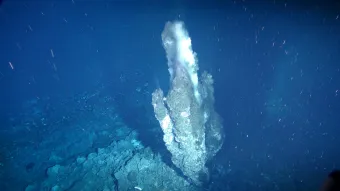
- Scientists have discovered that hydrothermal vents could provide a vital source of metals to the surface ocean that help phytoplankton to grow.
- Phytoplankton are tiny plants that form the base of the marine food web and play an important role in storing carbon that might otherwise be in the atmosphere.
- The study gives new insight into the natural sources of metals in the Southern Ocean, an area known to be particularly important for carbon storage.
Research from the National Oceanography Centre (NOC), University of Plymouth, University of Southampton and the British Antarctic Survey has found that hydrothermal vents could provide a vital source of nutrients for phytoplankton, tiny plants that help store carbon from the atmosphere in the Southern Ocean.
The paper published in Nature Communications Earth & Environment shows that the nutrients iron and manganese, are released in boiling water ejected from hydrothermal vents deep underwater and can reach the ocean surface where phytoplankton live. These metals boost a critical component of the Earth’s carbon cycle called the biological carbon pump, as phytoplankton use carbon dioxide from the atmosphere to grow which is then trapped within the ocean.
The remote Southern Ocean is known to have a critical shortage of these nutrients, suppressing the rate at which phytoplankton can use and store carbon dioxide. It has been known for a long time that a primary source of the metals in the Southern Ocean is from land dust. However, when studying water samples collected in December 2019 to January 2020 from the surface to the Southern Ocean’s seafloor kilometres below, scientists discovered an underwater plume of iron and manganese-rich water. Using state-of-the-art computer simulations, the team of scientists tracked the plume back to a source in the volcanic ridges crossing the Southern Ocean’s floor.
Chemical processes can gradually strip the metals out of the plume, but the simulations also allowed the team to show that it rises sufficiently rapidly to the surface to fertilise the Southern Ocean. Understanding the natural sources of these metals is vital for assessing the impact of proposed climate interventions such as artificial ocean fertilisation.
Dr Chelsey Baker, Ocean Biogeochemical Model Analyst at NOC and joint lead author said: “To avoid the worst outcomes of climate change, solutions have been proposed to enhance the oceans natural processes that remove carbon dioxide from the atmosphere. One suggestion is to fertilise places like the Southern Ocean with extra iron. However, we don’t fully understand the consequences of this for the ocean’s ecosystem. Knowing the natural sources of metals and how they support the biological carbon pump is crucial when assessing how effective such a direct climate intervention would be.”
Dr Antony Birchill Marine Biogeochemist at the University of Plymouth University and joint lead author said: “To find evidence for a new source of these metal nutrients in the Southern Ocean is very exciting. We already know that hydrothermal systems could be important from studies elsewhere but to find evidence for one deep in one of the most remote places on earth – a place which we also know is important for the biological carbon pump – is a major breakthrough.”
The research is part of the NOC-led and NERC funded, CUSTARD (Carbon Uptake and Seasonal Traits in Antarctic Remineralisation Depth) project looking at how marine life influences the uptake and storage of carbon in the Southern Ocean. The CUSTARD project is part of the UK NERC Role of the Southern Ocean in the Earth System programme. To find out more, visit: https://roses.ac.uk/about
Read the full paper: Pathways and timescales of Southern Ocean hydrothermal iron and manganese transport | Communications Earth & Environment (nature.com)
-ENDS-
Notes to editors
For press enquiries, please contact communications@noc.ac.uk
About NOC
NOC is the UK’s leading institution for integrated coastal and deep ocean research. NOC undertakes and facilitates world-class agenda-setting scientific research and technology development to understand the global ocean by solving challenging multidisciplinary, large scale, long-term marine science problems to underpin international and UK public policy, business and societal outcomes. NOC is a company limited by guarantee set up under the law of England and Wales (11444362) and registered as a charity (1185265).
NOC operates the Royal Research Ships James Cook and Discovery and develops technology for coastal and deep ocean research. Working with its partners NOC provides long-term marine science capability including: sustained ocean observations, mapping and surveying; data management and scientific research and advice.
Among the resources that NOC provides on behalf of the UK are the British Oceanographic Data Centre (BODC), the Marine Autonomous and Robotic Systems (MARS) facility, the National Marine Equipment Pool (NMEP), the National Tide and Sea Level Facility (NTSLF), the Permanent Service for Mean Sea Level (PSMSL) and British Ocean Sediment Core Research Facility (BOSCORF).